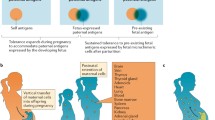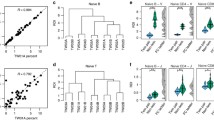Abstract
The production of Id-1, a cross-reactive idiotype associated with rat anti-group A streptococcal carbohydrate antibodies, by 11 strains of rats indicates that genes coding for Id-1 are in the germline. Its expression, however, follows a complex inheritance pattern. It was our intent in these studies to determine if immune responsiveness of streptococcus (GASV) immunized females could alter Id-1 expression of GASV-immunized progeny, and, in turn, introduce complications in Id-1 inheritance patterns.-We observed that Id-1-specific immune reactivity of GASV-immunized females could induce significant alterations in Id-1 production by progeny. The relationship between maternal and progeny Id-1 was complex, reflecting the complexity of autologous regulation of Id-1 production, and could be the opposite of what one would predict based upon parental transfer of Id-1 regulatory genes. The nongenetic nature of the maternal regulatory influence was confirmed by foster-mother studies.— We conclude that antigen-induced maternal immune responsiveness can exert a permanent regulatory influence on idiotype expression by progeny and consequently introduce error into the interpretations of idiotype inheritance patterns. The recognition of this maternal regulatory influence also lends further support to Jerne's hypothesis that idiotype-specific immune networks play a significant role in the regulation of immune responsiveness in vivo.
Similar content being viewed by others
References
Auerbach, R. and Clark, S.: Immunological tolerance: Transmission from mother to offspring. Science 189: 811–813, 1975
Barnetson, R. StC., Bjune, G., and Ducan, M. E.: Evidence for a soluble lymphocyte factor in the transplacental transmission of T-lymphocyte responses to Mycobacterium leprae. Nature 260: 150–151, 1976
Beer, A. E., Billingham, R. J., Head, J. R., and Parmely, M. J.: Possible influence of maternal-to-perinatal cell transfer on the development of host defenses. In M. D. Cooper and D. H. Dayton (eds.): Development of Host Defenses, pp. 251–271, Raven Press, New York, 1977
Bernstein, D., Klapper, D. G., and Krause, R. M.: Use of radioimmunoassays to determine the concentration of streptococcal group-specific antibodies in rabbit antisera. J. of Immunol. 114: 59–63, 1975
Brambell, R. W. R.: The Transmission of Passive Immunity frorn Mother to Young. Frontiers of Biology, Volume 18, American Elsevier, New York, 1970
Cosenza, H., Julius, M. H., and Augustin, A. A.: Idiotypes as variable region markers: Analogies between receptors on phosphorylcholine-specific T and B lymphocytes. Immunol. Rev. 34: 3–33, 1977
Dray, S.: Effect of maternal isoantibodies on the quantitative expression of two allelic genes controlling a y-globulin specificity. Nature 195: 677–680, 1962
Evans, D. I. K., Vyramuthu, N., and Palmer, M.: E-rosette-forming cell in mother and newborn. Lancet 1: 1078–1079, 1976
Field, E. J. and Caspary, E. A.: Is maternal lymphocyte sensitization passed to the child? Lancet 2: 337–342, 1971
Gorczynski, R. M. and Steele, E. J.: Inheritance of acquired immunological tolerance to foreign histocompatibility antigens in mice. Proc. Natl. Acad. Sci. U.S.A., in press, 1980
Halliday, R.: The absorption of antibodies from immune sera by the gut of the young rat. Proc. R. Soc. Lond. (Biol.) 143: 408–413, 1955
Hetzelberger, D. and Eichman, K.: Recognition of idiotype in lymphocyte interactions. III. Induction of nonresponsiveness with anti-idiotypic antibody: identification of the cell types tolerized in high zone and in low zone, suppressor cell-mediated idiotype suppression. Eur. J. Immunol. 8: 839–846, 1978
Jarrett, E. and Hall, E.: Selective supression of IgE antibody responsiveness by maternal influence. Nature 280: 145–147, 1979
Jerne, N. K.: Towards a network theory of the immune system. Ann. Immunol. (Paris) 125C: 373–389, 1974
Kindred, B. and Roelants, G. E.: Restricted clonal response to DNP in adult offspring of immunized mice: A maternal effect. J. of Immunol. 113: 445–448, 1974
Kindt, T. J., Seide, R. K., Lackland, H., and Thunberg, A. L.: Serologic identity of the b4 allotypic determinants present on homogenous rabbit light chains with different N-terminal amino acid sequences. J. Immunol. 109: 735–741, 1972
Klapper, D. G., Stankus, R. P., Leslie, G. A., and Capra, J. D.: Structural studies of induced antibodies with defined idiotypic specificities. IV. The heavy chains of anti-streptococcal group A carbohydrate antibodies from Sprague Dawley rats carrying a cross-reactive idiotype. Scand. J. Immunol. 5: 925–929, 1976
Leslie, G. A. and Clem, L. W.: Phylogeny of immunoglobulin structure and function. III. Immunoglobulins of the chicken. J. Exp. Med. 130: 1337–1352, 1969
Leslie, G. A. and Hattier, P. A.: Detection and quantitation of chicken antibodies to streptococcal carbohydrate by high-salt reverse radial immunodiffusion. J. Immunol. Methods 4: 53–58, 1974
Leslie, G. A.: Expression of a cross-reactive idiotype on the IgG2c subclass of rat anti-streptococcal carbohydrate antibody. Mol. Immunol. 16: 281–285, 1979
Loke, Y. W.: Immunology and Immunopathology of Human Fetal-Maternal Interaction, pp. 95–117, 141–159, Elsevier/North-Holland, Amsterdam, 1978
Loor, F. and Kelus, A. S.: Maternal allotype dominance and allelic exclusion in the B lineage cells of the newborn rabbit. Eur. J. Immunol. 8: 801–806, 1978
McConahey, R. J. and Dixon, F. J.: A method of trace iodination of proteins for immunological studies. Int. Arch. Allergy Appl. Immunol. 29: 185–189, 1966
Minami, M., Kanno, T., Matuhasi, T., and Suzuki, K.: The modification of immunological development of mice by maternal alloantibody. Jpn. J. Exp. Med. 47: 319–321, 1977
Ono, Y., Vasaki, T., and Ishida, N.: Regulation of clonal development of immune responding cells by antibody of maternal origin. Nature 250: 593–594, 1974
Peer, L. A.: Behavior of skin grafts exchanged between parents and offspring. Ann. N. Y. Acad. Sci. 73: 584–589, 1958
Stankus, R. P. and Leslie, G. A.: Cross-idiotypic specificity of rat antibodies to group A streptococcal carbohydrate. J. Immunol. 113: 1859–1863, 1974
Stankus, R. P. and Leslie, G. A.: Genetic influences on the immune response of rats to streptococcal A carbohydrate. Immunogenetics 2: 29–38, 1975
Stankus, R. P. and Leslie, G. A.: Rat interstrain antibody response and crossidiotypic specificity. Immunogenetics 3: 65–73, 1976a
Stankus, R. P. and Leslie, G. A.: Affinity-immunoadsorbent fractionation of rat anti-streptococcal A carbohydrate antibodies of restricted heterogeneity. J. Immunol. Methods 10: 307–316, 1976b
Stankus, R. P. and Leslie, G. A.: Interspecies and interantigenic evaluation of a crossreactive rat idiotype. Immunogenetics 4: 233–243, 1977
Steele, E. J.: Somatic Selection and Adaptive Evolution. On the Inheritance of Acquired Characters, Williams and Wallace International Inc. Toronto, 1979
Stern, C. M. M.: The materno-fetal transfer of carrier protein sensitivity in the mouse. Immunology 30: 443–448, 1976
Sy, M-S, Deitz, M. H., Germain, R. N., Benacerraf, B., and Greene, M. I.: Antigen and antigen-deriven regulatory mechanisms. IV. Idiotype bearing I-J+ suppressor T cell factors induce a secondorder suppressor T cell which express anti-idiotypic receptors. J. Exp. Med. 151: 1183–1195, 1980
Weiler, I. J., Weiler, E., Sprenger, R., and Cosenza, H.: Idiotype suppression by maternal influence. Eur. J. Immunol. 7: 592–597, 1977
Weinberger, J. Z., Germain, R. N., Benacerraf, B., and Dorf, M. E.: Hapten-specific T cell responses to 4hydroxy-3-nitrophenyl acetyl. V. Role of idiotypes in the suppressor pathway. J. Exp. Med. 152: 161–169, 1980
Author information
Authors and Affiliations
Rights and permissions
About this article
Cite this article
Olson, J.C., Leslie, G.A. Inheritance patterns of idiotype expression: maternal-fetal immune regulatory networks. Immunogenetics 13, 39–56 (1981). https://doi.org/10.1007/BF00524604
Received:
Revised:
Issue Date:
DOI: https://doi.org/10.1007/BF00524604




